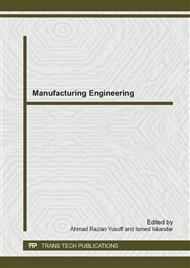[1]
Brundtland Commission Report, Our common future: From one earth to one world. Vol 5. Oxford University Press, World Commission on Environment and Development, 1987, pp.22-23.
DOI: 10.4324/9780203383797-20
Google Scholar
[2]
A.A. Martins, T.M. Mata, C.A.V. Costa and S.K. Sikdar, Framework for Sustainability Metrics, Industrial & Engineering Chemistry Research. 46(10), 2962-2973. (2006).
DOI: 10.1021/ie060692l
Google Scholar
[3]
H. Bossel, Indicators for sustainable development: Theory, method, applications, A report to a Balaton Group. International Institute for Sustainable Development (1999).
Google Scholar
[4]
B. Ness, E. Urbel-Piirsalu, S. Anderberg and L. Olsson, Categorising tools for sustainability assessment, Ecological Economics. 60(3), 498-508. (2007).
DOI: 10.1016/j.ecolecon.2006.07.023
Google Scholar
[5]
A.R. Hemdi, M.Z. Mat Saman and S. Sharif, Sustainability evaluation using fuzzy inference methods. International Journal of Sustainable Energy. 1(2011), 1-17.
DOI: 10.1080/14786451.2011.605947
Google Scholar
[6]
H. Briassoulis, Sustainable Development and its Indicators: Through a (Planner's) Glass Darkly, Journal of Environmental Planning and Management. 44(3), 409-427. (2001).
DOI: 10.1080/09640560120046142
Google Scholar
[7]
M. Mulder, Basic Principles of Membrane Technology, Center for Membrane Science and Technology, University of Twente, The Netherland, (1991).
Google Scholar
[8]
J. Suhana, A.F. Ismail and H. Shahrir, Preparation and characterization of polyethersulfone hollow fiber nanofiltration membranes made from PES/NMP/PEG 400/WATER, Proceedings of Regional Symposium on Membrane Science and Technology 21-25 April (2004).
Google Scholar
[9]
A. Idris, A.F. Ismail, M.Y. Noordin and S.J. Shilton, Optimization of cellulose acetate hollow fiber reverse osmosis membrane production using Taguchi method, Journal of Membrane Science. 205(1–2), 223-237. (2002).
DOI: 10.1016/s0376-7388(02)00116-3
Google Scholar
[10]
A.R. Hemdi, M.Z. Mat Saman and S. Sharif, An indicator for measuring sustainable product design: A review and future research, Proceeding Conference Scientific and Social Research 14-15 March (2009).
Google Scholar
[11]
H.A.O. Ying and G. Chen, Necessary Conditions for Some Typical Fuzzy Systems as Universal Approximators, Automatica. 33(7), 1333-1338. (1997).
DOI: 10.1016/s0005-1098(97)00026-5
Google Scholar
[12]
A.M.G. Cornelissen, J.V.D. Berg, W.J. Koops, M. Grossman and H.M.J. Udo, Assessment of the contribution of sustainability indicators to sustainable development: a novel approach using fuzzy set theory, Agriculture, Ecosystems & amp; Environment. 86(2), 173-185. (2001).
DOI: 10.1016/s0167-8809(00)00272-3
Google Scholar
[13]
J. Daniel, S. Solomon, D. Albritton, On the evaluation of halocarbons radiative forcing and global warming potential, Journal of Geophysical Research, 100, 1271-1285. (1995).
DOI: 10.1029/94jd02516
Google Scholar


